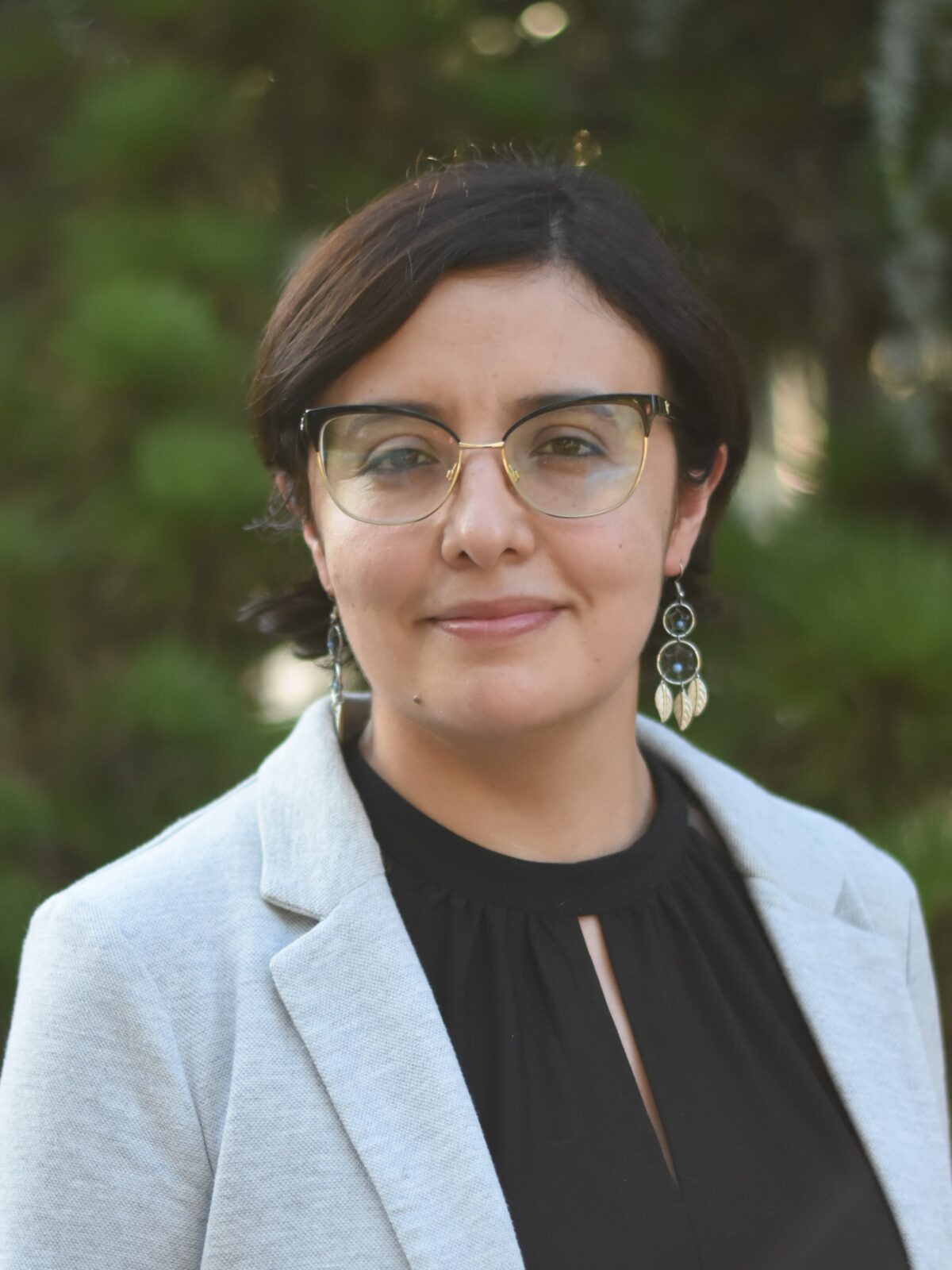Ana Ramírez
Biography:
Ana obtained her Diploma in Chemistry and Master’s Degree in Biochemistry from the National University of Colombia. She then moved to Frankfurt, where she completed her PhD in Biology at Goethe University. Afterwards, she joined the group of Kaspar Locher at ETH-Zurich where she investigated the structure and mechanism of glycosyltransferases involved in protein N-glycosylation. Since August 1, 2024, Ana has been part of the CCRC as an Assistant Professor.
Research Interests:
One of the main components of the eukaryotic glycocalyx is glycosylphosphatidylinositols (GPIs), which can exist as single glycolipids attached to the cell membrane or serve as membrane anchors of several cell-surface proteins. In parasitic protozoans, GPI and GPI-APs play an essential role in the invasion and modulation of host cells’ immune response.
The Ramírez Lab aims to understand the mechanistic basis of GPI assembly and remodeling in mammalian cells and parasitic organisms using a multidisciplinary approach involving structural biology and biochemical and biophysical characterization of the GPI assembly machinery.
https://www.ncbi.nlm.nih.gov/myncbi/1rsYyy0T-zbAd/bibliography/public/
Ian Wallace
Education:
Ian Wallace received his B.S. and Ph.D. in Biochemistry, both from the University of Tennessee, Knoxville. He graduated in 2008. Wallace has also been a Postdoctoral Research Associate at the Energy Biosciences Institute, UC Berkeley. Before his upcoming position with the CCRC, he was faculty at the University of Nevada, Reno for nine years, becoming Associate Professor and Graduate Program Director for their Biochemistry and Molecular Biology Department.
Research Interests:
Wallace studies the biosynthesis, deposition, and regulation occurring in plant cell walls, particularly the regulation of cellulose synthase catalytic subunits. He also researches plant protein kinase and phosphorylation-based signal transduction. Furthermore, he is interested in lignocellulosic biofuel and forage crop applications that come from understanding and manipulating plant cell wall digestibility.
More interests include the following:
- Hormonal regulation of plant metabolism and development
- Pollen-pistil interaction signalling
- Antimicrobial drug discovery and mechanistic analysis
Ryan Weiss
Short Biography:
Dr. Ryan Weiss received his B.S. in chemistry in 2008 at Point Loma Nazarene University in San Diego, CA. He then received his Ph.D. in chemistry in 2015 at the University of California, San Diego under the supervision of Prof. Yitzhak Tor. He then moved to the Department of Cellular and Molecular Medicine at the University of California, San Diego, where he worked as a postdoctoral fellow in the laboratory of Prof. Jeffrey Esko. Dr. Weiss began his independent career as an assistant professor in the Department of Biochemistry and Molecular Biology at the University of Georgia in January 2021. His current research interests include drug discovery and using genomic tools to understand the regulation of glycosylation in human diseases.
Research Interests:
Complex carbohydrates play important roles in many cellular processes and their dysregulation has been implicated in many disease states, including cancer, pathogen infection, and rare genetic disorders. The mammalian glycome contains extensive structural and functional heterogeneity that can vary temporally and spatially during development and in different tissues. Currently, little is known about the regulation of the non-template driven assembly of these ubiquitous post-translational modifications. My current research interests are focused on studying the structure, function, and genomic regulation of complex carbohydrates in human biology and disease. In particular, my laboratory is focused on identifying the transcriptional and epigenetic programs responsible for temporal and spatial control of glycosylation using genome-wide, molecular, and chemical approaches. In addition, we are dedicated to developing pharmacological and cell-based tools to aid in the discovery of novel targets and therapies for modulating glycan and glycoprotein expression in human diseases.
- Functional Genomics of Glycosaminoglycan Biosynthesis
In the Weiss lab, we utilize pooled genome-wide CRISPR screening approaches, genetic engineering, and bioinformatic tools to identify the molecular mechanisms responsible for the regulation of glycosaminoglycan biosynthesis in human cells.
- Drug Discovery for Rare Genetic Disorders
Many human diseases are caused by rare mutations in genes involved in the biosynthesis and/or catabolism of glycans. In the Weiss lab, genetic engineering, high-throughput drug screening, and cell-based disease models are utilized to uncover novel drug targets and therapeutic agents to treat these rare genetic disorders.
- Epigenetic and Transcriptional Regulation of Glycan Assembly
Epigenetic changes alter the physical structure and organization of DNA, and transcription factors regulate the expression of their genomic targets. Currently, little is known about the genomic regulation of glycosylation. The Weiss lab aims to use state-of-the-art genomic tools and pharmacological agents to identify and modulate novel regulatory pathways responsible for controlling glycosylation in mammalian cells.
Gerald Hart
Gerald Warren Hart, Ph.D.
October 1st, 2018, Hart moved to take a position as the Georgia Research Alliance William Henry Terry, Sr. Eminent Scholar in Drug Discovery, and Professor of Biochemistry and Molecular Biology at the Complex Carbohydrate Research Center, University of Georgia. Prior to that appointment, he worked at Johns Hopkins Medical School for 41 years. He has served as the Director of Biological Chemistry at JHU SOM for over 20 years. Hart was elected as a Fellow of ASBMB in 2022 and the President of ASBMB (2018-2020). Hart received the 2019 President’s Innovator Award from the Society for Glycobiology (SFG), the 2018 Herb Tabor Award from ASBMB, the 2018 Yamakawa award from the Japan Consortium for Glycobiology and Glycotechnology, the Karl Meyer Award from SFG in 2006, and the first IGO Award from the International Glycoconjugate Organization in 1997. He was an Associate Editor of the Journal of Biological Chemistry (2012-2022) and of Molecular and Cellular Proteomics (currently). He also founded the journal Glycobiology in 1989, now the leading journal in the field and served as its Editor-In-Chief for 12 years. During his graduate career, he performed some of the earliest studies on cell surface heparan sulfates and on the roles of proteoglycans and sulfotransferases in corneal transparency. During his postdoctoral work, he determined the minimal sequence requirement for N-glycosylation (-Asn-X-Ser-) and showed that corneal keratan sulfate is made via the N-glycan biosynthetic pathway. In 1983, Hart’s laboratory discovered O-GlcNAcylation, he co-led elucidation of GPI anchor biosynthesis with Paul Englund’s group, and his lab documented the importance of protein structure for N-glycosylation. His lab later discovered the extensive crosstalk between O-GlcNAc and phosphorylation, which regulates transcription and signaling and underlies the etiology of diabetes, neurodegenerative disease, cardiovascular disease and cancer. ~319 publications; Google H-factor = 129; i10-index=284.
William York
Short Biography:
Dr. York received his B.A. in molecular, cellular, and developmental biology in 1978 from the University of Colorado and his Ph.D. in biochemistry and molecular biology in 1996 from the University of Georgia. He was senior research chemist at the CCRC from 1985-96. Full publications: 96.
Research Interests:
Dr. York’s diverse research interests include the development and application of spectroscopic and computational methods for the structural and conformational analysis of complex carbohydrates, the development of bioinformatics tools to study the roles of carbohydrates in living systems, and the use of these tools to develop realistic models describing the assembly and morphogenesis of the “primary cell walls” that surround the growing cells of higher plants.
His early research focused on the analysis of plant cell walls using a multidisciplinary approach. Extensive spectroscopic analysis of xyloglucan, a load-bearing polysaccharide involved in controlling the rate and orientation of cell wall growth, have been performed in Dr. York’s laboratory. The results of these spectroscopic studies have been summarized in the form of a database that provides chemical shift information taken from the NMR spectra of over 50 xyloglucan oligosaccharides that have been characterized in Dr. York’s laboratory. The organization and user interface of this database facilitates the retrieval of information regarding specific correlations between structural featurres of the oligosaccharides and the chemical shifts of diagnostic resonances in the NMR spectra. The availability of this information makes it possibly to rapidly and accurately identify oligosaccharides that are present in the database and to identify structural features of related oligosaccharides that have not yet been characterized. As a result of Dr. York’s interest in database development and data mining methodology, he has recently initiated a bioinformatics project as part of the Integrated Technology Resource for Biomedical Glycomics funded by the National Center for Research Resources of the NIH.
The Plant Cell Wall. Expansion of the primary cell wall determines the final size and shape of each plant cell, thereby defining the morphology of the entire plant. It is generally accepted that, with the exception of cellulose, the macromolecular components of the primary cell wall are synthesized within the Golgi and exported to the apoplasm. Cellulose, which is synthesized at the plasmalemma, combines with these components to form a cross-linked matrix (the primary cell wall) that expands at a controlled rate in a defined direction. The process of cell wall assembly thus depends on the incorporation and subsequent reorganization of polysaccharides. In order to develop a coherent picture of this complex process, it is necessary to combine information regarding the biosynthetic mechanisms and chemical structures of cell wall polysaccharides, the physical bases for their assembly (i.e., their molecular conformations and dynamics), the nature of their covalent and non-covalent interconnections, the specificity and regulation of enzymes that catalyze the formation and/or cleavage of these interconnections, the overall topology of interconnected polysaccharide networks, and the rheological consequences of these interacting factors. This is a formidable problem demanding a multidisciplinary approach.
York is addressing this problem by examining the structural details of the cell walls of various plants, thereby determining how their primary, secondary, and higher-order structures vary from tissue to tissue and from plant to plant. Conserved features are likely to confer essential functions upon the cell wall. For example, features that are consistently associated with a specific developmental stage or morphogenetic process (e.g., cell elongation) probably play important roles in plant cell differentiation. The abundance of individual oligosaccharide subunits of the polysaccharide may vary, or novel, chemically modified subunits may be produced at specific developmental stages. For further information regarding the mulitdisciplinary study of plant cell walls see the CCRC’s Plant Cell Walls Web Site.
Spectroscopic methods to analyze complex glycans. Although much less sensitive than chromatographic and mass spectral methods, NMR spectroscopy can often provide all of the information necessary to completely define the primary structure of a complex glycan. York and his colleagues have used NMR (along with other techniques) to determine the primary structures of more than 50 oligosaccharides derived from XGs isolated from the cell walls of various plants. These analyses make it possible to identify previously characterized XG oligosaccharides by their NMR spectra and have revealed many correlations between the structural features of XG oligosaccharides and characteristic resonances in their NMR spectra, facilitating the structural analysis of novel XG oligosaccharides. Continued development of this approach will provide crucial information necessary for studying cell wall structure and metabolism, and is a prerequisite for the comprehensive application of chromatographic methods that rely on well characterized standards.
Recently, York and colleagues have developed methods for the selective fragmentaion of pectic polysaccharides based on β-elimination reactions. Effective utilization of this class of reactions to break pectic polysaccharides into well-defined fragments has been a long-standing goal in the plant cell wall research community. The new methods developed in York’s lab have the potential to greatly simplify the characterization of pectic polysaccharides that are modified as plant cells develop.
In collaboration with other scientists at the CCRC (notably the Orlando Laboratory) York has developed new methods using isobaric labeling and multiple mass spectrometry (MSn) techniques to simultaneously identify and quantitate glycans at high sensitivity. The new method, called Quantitation by Isobaric Labeling (QUIBL) can even be used to quantitate mixtures of isomeric glycans, which is extremely difficult using more traditional methods.
The molecular conformations and dynamics of complex glycans. The assembly and expansion of the primary plant cell wall is directed by the conformation and dynamics of the cell wall polysaccharides that must interact during this process. York and co-workers have developed models, based on conformational energy calculations, for the incorporation of XGs into the primary cell wall. These calculations suggest that the XG can adopt specific, low energy conformations that allow all of the side chains to fold onto one face of the XG chain, freeing the other face to interact with cellulose. Rigorous evaluation of this model will require further experimental and computational analyses, and will depend on improvements in the accuracy of molecular force fields.
Polysaccharides and other glycans often exhibit complex dynamic behavior in solution because they can adopt many different low energy conformations, making them difficult to study by crystallographic and spectroscopic techniques. Their flexibility, compared to globular proteins, may paradoxically arise from the rigidity of the glycosyl residues from which they are constructed. Rigid glycosyl residues may not fold into a neatly packed, low energy structure the way the flexible amino acid side chains of a typical protein do. Therefore, it is often proper to define the conformation of a complex glycan in terms of an ensemble of interconverting states. NMR spectroscopy is the most frequently used technique to study these dynamic ensembles, but it rarely provides sufficient information to describe them in detail. Therefore, conformational models must rely on the agreement of computational methods with experimental methods such as NMR. Although these rapidly evolving techniques currently provide a limited picture of the conformational dynamics of complex glycans, they are indispensable tools for elaborating a dynamic structural model of the primary cell wall.
Informatics for glycobiology and glycomics. Dr. York has a long-standing interest in informatics technology that can be applied to complex glycan structures. He was actively involved in the creation of CARBBANK, which was the first worldwide, comprehensive database of glycan structures. More recently, York has been developing methods for the exchange of glycan structural data over the Internet. His most important contribution in this area is GLYDE-II, an XML standard for structural data exchange that has been accepted as the standard protocol by the leading carbohydrate databases in the United States, Germany, and Japan.
Dr. York’s work is supported by the United States Department of Agriculture, the Department of Energy, the National Science Foundation, The National Institutes of Health, and the University of Georgia Research Foundation.
Robert J Woods
Short Biography:
Dr. Woods received both his B.Sc.(Honors) in engineering chemistry in 1985 and his Ph.D. in 1990 in computational and synthetic organic chemistry from Queen’s University in Kingston, Ontario, Canada. He joined the CCRC in January 1995. Dr. Woods is a senior investigator on a technological research and development project of the National Institutes of Health Resource Center for Biomedical Complex Carbohydrates. He has been invited to write an entry on carbohydrate force fields for the Encyclopedia of Computational Chemistry. He is a member of UGA’s Campus Information Technology Forum and the UGA Modeling Laboratory Operations Committee, and has made recent presentations at the International Carbohydrate Symposium, the Gordon Research Conferences, and the National Research Council of Canada. Full publications: 33.
Research Interests:
Dr. Woods’s research examines the relationships between the conformations of carbohydrate molecules and biological recognition and activity, particularly the mechanisms involved in carbohydrate recognition in immunological events. Significant alterations in the biological activities of peptides and proteins often accompany the covalent attachment of an oligosaccharide (glycosylation) to one or more of their amino acid residues. Approximately 60% of all mammalian proteins are glycosylated, and the glycoproteins that are generated by glycosylation are also frequently found attached to the cell surfaces of bacteria, fungi, and parasites.
But the roles of oligosaccharide moieties are extremely diverse. In mucins, for example, the carbohydrate component of a glycoprotein may be present in a largely structural capacity, whereas in human chorionic gonadotropin or tissue plasminogen activator it alters the functioning of the protein. The carbohydrate component may also be the part of the glycoprotein recognized by the immune system, directly affecting antibody-antigen interactions, self- and non-self-recognition, and auto-immune disorders. Recognition by the host’s immune system of the carbohydrate portion of the glycoproteins of these pathogenic microorganisms is essential for an immune response to be generated by the host. Moreover, an understanding of the factors that enable antibodies to distinguish among glycoproteins is essential to the rational development of vaccines. Elucidating the conformational properties of glycoproteins and their carbohydrate components is key to this understanding. Dr. Woods’s investigations seek to define the conformational properties of the free oligosaccharides of such glycoproteins, the effect of attachment of the oligosaccharide to the protein, and the mechanisms of non-covalent oligosaccharide-protein interactions.
Traditional experimental techniques that have been successfully applied to proteins have not been able to determine conclusively the conformational properties of glycoproteins. The conformation of an oligosaccharide in aqueous solution is determined by interactions (both steric and electronic and between both attached and nonbonded atoms) between the sugar residues and between these residues and solvent molecules. All these interatomic interactions must be adequately described in order to arrive at an accurate prediction of an oligosaccharide’s conformational preferences. Moreover, the structure may need to be described as an ensemble of conformations rather than as a single conformation, accounting for both spatial and temporal properties of the oligosaccharide. Mathematically, such a description can be obtained by applying a molecular mechanical force field in molecular dynamics (MD) simulations, a standard technique in the analysis of protein and oligonucleotide structures.
Dr. Woods’s group utilizes, in conjunction with experimental methods (e.g., 2D 1H-NMR spectroscopy), the computational techniques of molecular dynamics (MD) and free energy perturbation simulations to elucidate the conformational properties of oligosaccharides. Simulations are in no way constrained to reproduce the experimental data. The computational simulations use the all-atom AMBER force field for proteins and nucleic acids and a novel set of parameters developed by Dr. Woods’s group for use with carbohydrates, GLYCAM. The GLYCAM parameters make it possible to probe the interatomic interactions responsible for oligosaccharide and glycoprotein dynamics and compare these directly with experimental NMR data that are often consistent with numerous possible conformations. These parameters are currently suitable for all biologically relevant N- and O-linkages in oligo- and polysaccharides and glycoproteins.
Current research projects using these techniques include examinations of bacterial antigen-antibody interactions, as well as carbohydrate-lectin interactions. Carbohydrate antigens associated with Salmonella paratyphi B and group B Streptococcus are being studied to understand the energetic contributions hydrophobic and hydrophilic interactions make to antibody binding energy. More applied aspects of the research include the screening of synthetic combinatorial peptide libraries for peptides that bind to carbohydrate receptor proteins (antibodies and lectins) and their subsequent co-crystallization with the receptor. Peptides are characteristically more antigenic than carbohydrates, and the Woods laboratory’s interest in carbohydrate mimics is driven by a desire to produce non-carbohydrate molecules that can either act as anti-bacterial vaccines or inhibit auto-immune reactions.
Dr. Woods’s research is supported by the National Institutes of Health and the National Science Foundation.










